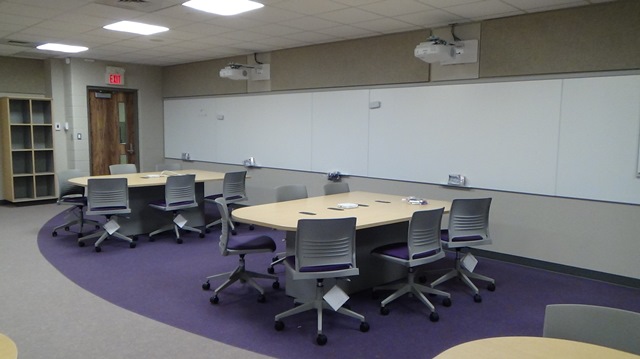WALS (Western Active Learning Space): A Passport to Active Learning
*Originally published in the Fall 2014 issue of the Teaching Support Centre’s Reflections Newsletter.
Amid the usual excitement and expectations that a return to school brings, Western students can look forward to learning in a new classroom environment this year. Imagine a classroom where space, technology, and active learning pedagogy come together seamlessly to support the best possible teaching and learning experience. That classroom is here at Western in UCC 66, and it is a new iteration of the traditional General Use (GU) classroom space.
What is WALS?
While the construction of an active learning classroom had been discussed for several years, the plan became a reality in 2013 when a Productivity Innovation Grant from the Ministry of Training, Colleges, and Universities was realized and matched by funds from Western. Since November 2013, a committee comprised of representatives from Information Technology Services and the Instructional Technology Resource Centre, Institutional Planning and Budgeting and the Classroom Management Group, Facilities Management, as well as the Teaching Support Centre have collaborated to create Western’s first GU active learning space. WALS is the first classroom of its kind at Western that enables teachers and learners to choose from a range of features to promote interaction for deeper learning. For example, WALS has comfortable swivel chairs grouped around D-shaped tables, whiteboards surrounding the room, interactive whiteboard capabilities at each table, and the ability for students to connect wirelessly to the technology in the space using their own Mac or PC laptops, tablets, and smartphones. In WALS, technology becomes another tool for deep learning. In the words of Chickering and Gamson (1987):
“Learning is not a spectator sport. Students do not learn much just by sitting in class and listening to teachers, memorizing pre-packaged assignments, and spitting out answers. They must talk about what they are learning, write about it, relate it to past experiences, apply it to their daily lives. They must make what they learn part of themselves” (p.3).
This kind of interactive, collaborative learning is a cornerstone of the design of the WALS space, and is evidenced by the layout of the room, the choice of furniture, and the plethora of materials and methods for recording and sharing ideas. One of the most unique elements of the WALS classroom is the Observation Room. In accordance with appropriate ethics for both students and instructors, we anticipate using this room to conduct Scholarship of Teaching and Learning (SoTL) research in the space. Further, we look forward to hosting “viewings” for those instructors who would like to teach in WALS but who are uncertain of what active learning “looks like.” Led and narrated by members of the Teaching Support Centre staff, focused observations of experienced teachers will assist in supporting active learning principles for instructors and will help frame technology as a teaching tool across disciplines and programs at Western. Further, research conducted using the Observation Room will add to the growing body of knowledge related to active learning and technology enhanced teaching in higher education through SoTL.
How was it conceived?
WALS was conceived using Shirley Reushle’s PaSsPorT model (2009), a theoretical framework that signifies the importance of synergy between People, Space, Pedagogy, and Technology in active learning spaces. Members of the Teaching Support Centre staff also participated in several collaboratories with other large research and teaching institutions across Canada and the United States to learn from those who had designed and built active learning classrooms. In creating WALS, careful attention was paid to the layout of space, the choice of furniture, the integrated nature of the technology, and opportunities to include high-impact pedagogical approaches to teaching. Further, WALS was created using principles of universal design that require planners to think intentionally and inclusively about the way in which the space will be used. Inherent in the design are wide aisles to accommodate flexible groupings of students, whiteboards that can be accessed at a number of levels, and lighting designed for four “scenes” (from full overhead lights, to dimmed classroom and task lighting, to a setting for working on the interactive whiteboards).
Who is using WALS?
The response to Western’s Active Learning Space has been overwhelming! Two graduate courses – one in Statistics and one in Library Science – already held their class in the temporary WALS lab during Intersession, and the word cloud below represents the faculties who have been teaching in the space up to the time of writing. As a GU classroom, the booking is done centrally and any faculty or unit can schedule their program to use the space. However, because of the uniqueness of WALS, there is a need to meet with the personnel at the Teaching Support Centre before working in the classroom so instructors can be introduced to the special technological features and active learninng considerations of the space.
Further information about Western’s Active Learning Space, including the booking calendar and form, can be found on the web site at www.uwo.ca/WALS. Follow us
on Twitter @WALS_Western.
References
Chickering, A.W. & Gamson, Z.F. (1987). Seven principles for good practice. AAHE Bulletin, 39 (7), 3-7.
Rueshle, S. (2013). PaSsPorT model presented at the University of Canberra’s SAFFIRE Festival. Retrieved from http://adfi.usq.edu.au/blog/?tag=learning-spaces
Zimmermann, R. (2006). Universal design means accessibility for one and all. Retrieved from http://www.facilitiesnet.com/ada/article/Accessibility-for-One-and-All--5573#
Teaching Support CentreRoom 122, The D.B. Weldon Library
Western University
London, Ontario N6A 3K7
(519) 661-2111, ext. 84622
tsc@uwo.ca


